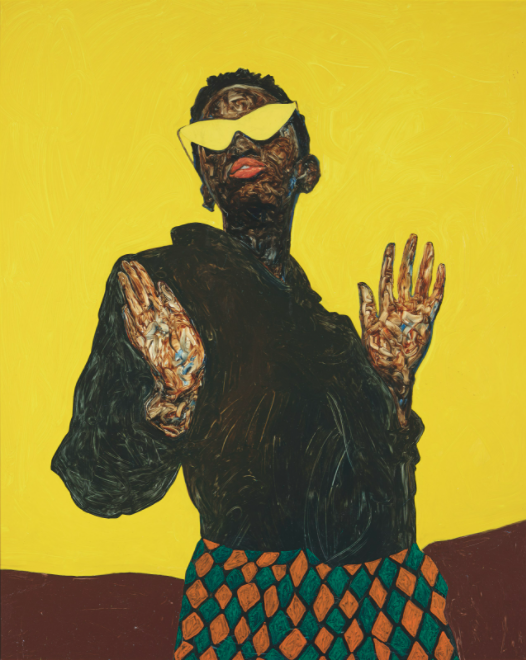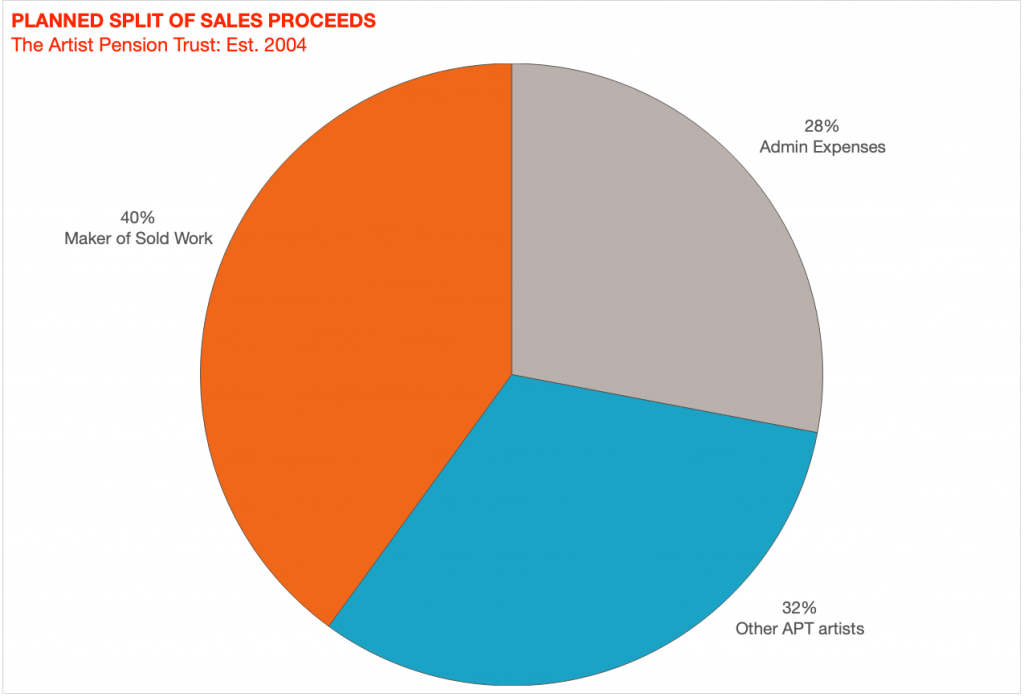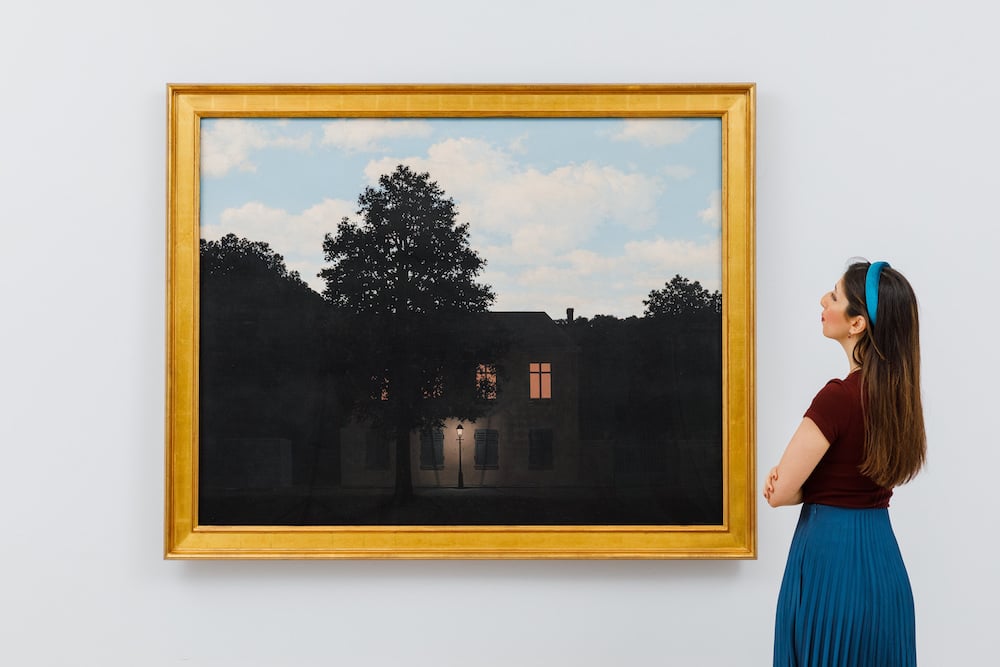The Back Room
The Back Room: Bright Lights, Big Promises
This week: new African art in the limelight, the Artist Pension Trust in shambles, Magritte in the record books, and much more.

This week: new African art in the limelight, the Artist Pension Trust in shambles, Magritte in the record books, and much more.

Every Friday, Artnet News Pro members get exclusive access to the Back Room, our lively recap funneling only the week’s must-know intel into a nimble read you’ll actually enjoy.
This week in the Back Room: new African art in the limelight, the Artist Pension Trust in shambles, Magritte in the record books, and much more—all in a 7-minute read (2,091 words).
__________________________________________________________________________

Amoako Boafo, Hands Up. Courtesy of Christie’s.
Over the past few years, keeping a handle on the art-market has often felt like a juggling act in which each ball is just a different target of speculation. Since early 2021, however, the shiniest and fastest-spinning of them all may be figurative works by ultra-contemporary African artists.
This week, Katya dialed in on the frenzy surrounding molten-hot talent from Ghana, Ivory Coast, Nigeria, and South Africa. With dealers “routinely selling out shows” of their new works, the mismatch between scant supply and rabid international demand has led to explosive results in auction salesrooms stretching from New York and London, to Hong Kong and Beijing.
The gold rush has become so intense that works only a few months removed from the studio are commanding multiples of their high estimates at auction—sometimes even before their creators secure gallery representation, let alone institutional support.
The surge marks a sharp reversal for the contemporary African art market, which was still receiving relatively little global attention as recently as the mid-2010s. The change may leave you asking questions like…
Was There a Clear Genesis for This Movement?
Yes, and his name is Amoako Boafo. Born in Ghana’s capital, Accra, and now based in Vienna, Boafo entered the arena thanks in no small part to Kehinde Wiley, who recommended the artist to his Los Angeles dealer Bennett Roberts (of Roberts Projects) after encountering Boafo’s work on Instagram.
Roberts gave Boafo his first solo gallery show in 2019, but it wasn’t until his Art Basel Miami Beach-synced exhibition at the Rubell Museum that year (when he was the Rubell’s artist-in-residence) that, in Katya’s words, “all hell broke loose” in his market.
Uh Oh, What Happened Next?
First, dealer Mariane Ibrahim sold out her booth of Boafo portraits at ABMB, at prices from $15,000 to $45,000 each. Then, in 2020, 32 paintings by Boafo generated $8.2 million at auction, according to the Artnet Price Database.
In 2021, fewer works (19 in all) amassed even more revenue under the hammer: $11.6 million, with almost one-third of the total ($3.4 million) coming from the sale of his 2018 painting Hands Up at Christie’s Hong Kong in December.
Did Boafo’s Boom Set a Precedent?
You better believe it. Auction sales of work by ultra-contemporary African artists (meaning those born after 1974) have increased 434 percent in two years, from $7.5 million in 2019 to almost $40 million in 2021, according to the Artnet Price Database.
Where Are the Houses Getting Such In-Demand Works?
Some of the works flipped last year can be connected to figures familiar to speculators, like Stefan Simchowitz. In the years since helping to inflate the Zombie Formalist bubble, he has pivoted to championing multiple young Black artists whose early works have gone on to incite bidding wars at auction.
For example, Simchowitz programmed his L.A. gallery with a solo show by 37-year-old Ghanaian artist Serge Attukwei Clottey last spring. Less than six months later, Fashion icons (2020–2021), a portrait included in that exhibition, sold for £340,000 ($468,000), more than 10X its low estimate, at Phillips London in October.
Which Other Young African Artists’ Works Are Thriving at Auction?
Some notable results include…
Sheesh, So Are Blue-Chip Dealers Joining the Fray?
They’re starting to. Marianne Boesky’s New York flagship currently has on view a group exhibition co-curated by Boafo and critic Larry Ossei-Mensah highlighting new voices from Africa and its diaspora, including Ghanaian Aplerh-Doku Borlabi and Ethiopia-born, Germany-based Nigatu Tsehay. The works explore the Black figure in a variety of styles and techniques, from mixed-media painting to collage.
Boesky, who said she is “focused on placing the work in good hands,” said that pieces by almost all the featured artists had found buyers before the show opened yesterday (January 13), at prices up to $30,000 each.
She also stated that her invoice terms seek to limit the buyers’ ability to resell the works. Whether or not those conditions will be enough to mute the siren song of speculation, however, remains an open question.
__________________________________________________________________________
In the short term, demand is likely to keep growing for works by young artists from Africa and its diaspora, especially now that the competition is wealthier, more global, and better connected than ever. Rebekah Bowling of Phillips even used her interview with Katya partly to put out an open call for figurative paintings by Ludovic Nkoth, a Cameroon-born figurative painter whose show “people went crazy for” at François Ghebaly gallery in L.A.
If that’s not a sign that we’re nearing the top of this market, it should mean we’re close. Here’s hoping the speculative pandemonium for these new rising stars ends with less carnage than the Zombie Formalist apocalypse. I just wouldn’t bet on it, literally or figuratively.
____________________________________________________________________________
In the latest Wet Paint, we learned that Gagosian has hired Bechet Allen, the adopted daughter of disgraced filmmaker Woody Allen and Soon-Yi Previn, as a front desk associate at the gallery’s Upper East Side space.
Meanwhile, a mysterious prankster posing as Nancy Pelosi has been trolling the art world over Paul Chan’s divisive drawing of the Capitol insurrection on view at Greene Naftali gallery.
Here’s what else made a mark around the industry since last Friday morning…
Art Fairs
Victoria Siddall will exit her role as global director of all Frieze fairs worldwide at the end of February. Although she will remain on Frieze’s board and advise the company on its inaugural expo in Seoul this September, she will not be replaced. Instead of a global director, Frieze will content itself with individual directors of each fair working in concert with executive director Kristell Chade. (The Art Newspaper)
Swiss fair Art Genève became the latest to postpone its January dates due to the Omicron surge. The expo will now take place March 3–6. (Artnet News)
The Grand Palais in Paris is holding off until the end of the month to announce whether RX France, the parent company of FIAC and Paris Photo, will get to keep its slots for the two events at the prestigious institution in the face of a competing offer. (Financial Times / Artnet News)
Auction Houses
Phillips appointed Jean-Paul Engelen to the newly created role of president of the Americas. He will also continue on as co-head of 20th century and contemporary art. (Press release)
Bonhams paid an undisclosed amount to acquire Swedish auction house Bukowskis, in the hope that Stockholm and Helsinki locations will beef up Bonhams’s influence in Europe. (Artnet News)
Sotheby’s lawyers are trying to bat down a lawsuit from a New Jersey accountant alleging that the house denied workers benefits by misclassifying them as independent contractors. (The Art Newspaper)
Galleries
Pace announced its global representation of Korean performance-art pioneer Lee Kun-Yong, whose third solo show with the gallery debuts in Hong Kong today. Lee will continue working with his two South Korean dealers, Gallery Hyundai (Seoul) and Leeahn Gallery (Daegu). (ARTnews)
Mitchell-Innes and Nash now reps award-winning multimedia artist, curator, and writer Tiona Nekkia McClodden. A selection of her work will be included in a group show at the gallery’s seasonal space in Mexico City next month. (Press release)
Kamel Mennour will take on the estate of Polish-born Jewish painter Maryan, currently the subject of a much-praised retrospective at the Museum of Contemporary Art North Miami. (ARTnews)
Institutions
The Institute of Contemporary Arts in London has appointed Bengi Ünsal as its new director, beginning March 2022. Formerly head of contemporary music at the Southbank Center, she is the the first woman to serve as director of the ICA in 55 years and was appointed under the chairmanship of Wolfgang Tillmans. (Press release)
Art critic Guillaume Désanges has been named the new president of Paris’s Palais de Tokyo. He replaces Emma Lavigne, who left to run François Pinault’s Bourse de Commerce. Désanges has promised to return the museum’s programming to its “avant-garde” roots. (ARTnews)
Staff at the Jewish Museum in New York intend to vote on whether to unionize, and the pro-union faction at the Art Institute of Chicago won its election on the same subject. (Artnet News / ARTnews)
NFTs and More
Leo Villareal is offering his first NFTs, a series of 1,024 digital works entitled “Cosmic Reef,” on the generative-art platform Art Blocks on January 24. (Press release)
JPG, a new website that allows users to import and display any NFT on OpenSea in their own online NFT “gallery,” received $3.8 million in a recent seed-funding round. (ARTnews)
____________________________________________________________________________

© 2022 Artnet Worldwide Corporation.
In 2004, serial entrepreneur Moti Shniberg teamed up with risk-management expert Dan Galai and former SFMOMA director David Ross to cofound the Artist Pension Trust, a novel entity that sought to use art capitalism to collectivize long-term financial support for participating artists.
The original plan was for each artist to contribute one work to the trust annually for 20 years, with the following split applying to all sales made by the APT: 40 percent to the artist who created the sold work, 32 percent to be evenly distributed among the other artists, and 28 percent to cover the trust’s expenses.
The APT eventually expanded to include 2,000 artists who supplied more than 13,000 artworks with a combined value once estimated at $500 million. But instead of the scheme providing a more stable future for its constituents, it has instead eroded into one of the most notorious cautionary tales of the 21st century art industry.
The artists involved now find themselves “confronting a kind of zombie corporation, unable to obtain basic information like where their works were stored, or even receive responses to their emails,” according to Catherine Wagley. Her two-part investigation into the APT’s rise and fall is must-read material for any art pro. Click through below to see how it all went wrong, and how other organizations are trying to learn from the APT’s errors.
____________________________________________________________________________
“There may be something to that… But I never had anything on my walls I didn’t really love.”
—Embattled financier and collector Ronald Perelman, responding to the notion that his ceaseless drive for bargains led his art holdings to top out at “good paintings by great artists” instead of trophy works… and possibly explaining why “much” of the art he recently divested through Sotheby’s “sold at the bottom end of estimates,” per journalist Jacob Bernstein. (The New York Times)
____________________________________________________________________________

Rene Magritte, L’empire des lumières (1961) . Image courtesy Sotheby’s.
____________________________________________________________________________
Estimate: In excess of $60 million
Selling at: Sotheby’s London, March 3
Auction houses rarely expect to more than double the highest-ever price for a work by a giant of Modernism, but Sotheby’s is going big with this Magritte, as Eileen Kinsella covered this week. On Tuesday, the House of Drahi trotted out L’empire des lumières (1961), whose estimate “in excess of $60 million” (my favorite verbiage in the sector) makes the $26.8 million paid for the artist’s Le Principe du plaisir (1937) at Sotheby’s New York in November 2018 sound like pocket change.
When bidding opens for L’empire des lumières at Sotheby’s modern and contemporary evening sale in London on March 3, it will mark the painting’s first appearance on the resale market. Magritte created the work for Anne-Marie Crowet Gillion, the daughter of one of his most important patrons; the artist called Anne-Marie, who went on to model for him many times, his “ideal” muse. The painting has remained a part of the Crowet Gillion collection in Belgium throughout the ensuing six decades.
Yet the family has been liberal about loaning it to prestigious destinations. L’empire des lumières was included in several major institutional shows on Magritte’s work, and it has been on view in the Magritte Museum in Brussels for the past 10 years. The painting will go on a different kind of business trip in the weeks leading up to its auction debut, making stops at Sotheby’s locations in Los Angeles, New York, and Hong Kong before it lands in London for the sale.
Where it goes from there is anybody’s guess. Just expect the journey to be propelled by a jet stream of cash like no Magritte before it.
____________________________________________________________________________
Additional reporting and writing by Naomi Rea.